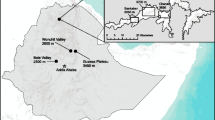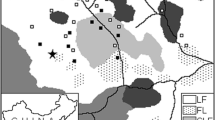Abstract
The guanacoLama guanicoe Muller, 1776 has a wide distribution along the Andes and Patagonia. We studied the feeding behaviour of a guanaco population that lives over 4100 m altitude in the Andes of north-central Chile. By contrasting the diet of guanacos during a dry year with that of a wet year and comparing it with the plant availabilities in the field, we tested the hypothesis that the guanaco is a generalist herbivore. We predicted that under such extreme habitat conditions guanacos should consume whatever plant species are available in the environment, especially in a dry year, when vegetation is scarcer. In addition, we compared its diet at three different age classes. We estimated the diet through the microhistological analysis of plant remains found in guanaco pellets collected during January of 1997 (ie after a dry year) and 1998 (ie after a wet year; 41 vs 495 mm, respectively). Then, we computed dietary preferences, food niche-breadth, and food-niche overlap between years and among age classes. Vegetation cover and plant species richness were higher during the wet than during the dry year. The most common plants in the environment were perennial graminoids and legumes. Contrary to our prediction, the guanaco preferred a few plant species, showing a relatively narrow diet breadth that changed little between years differing in plant abundances. The diet proportions differed among the three age classes, however. Our data indicate that at least in this high-elevation population, guanacos are selective and non-opportunistic herbivores. This specialized feeding behaviour is puzzling given the energetic demands of living in a harsh environment with low availabilities of resources. The hypothesis that this is due to the lower palatability of the plants not eaten, remains to be tested.
Similar content being viewed by others
References
Baldi R., Albon S. D. and Elston D. A. 2001. Guanacos and sheep: evidence for continuing competition in arid Patagonia. Oecologia 129: 561–570.
Baumgartner L. L. and Martin A. C. 1939. Plant histology as an aid in squirrel food-habits studies. The Journal of Wildlife Management 3: 266–268.
Bonino N. and Pelliza-Sbriller A. 1990. Composición botánica de la dieta del guanacoLama guanicoe en dos ambientes contrastantes de Tierra del Fuego. Ecología Austral (Argentina) 1: 97–102.
Bonino N. and Pelliza-Sbriller A. 1991. Comparación de las dietas del guanaco, ovino y bovino en Tierra del Fuego, Argentina. Turrialba (Costa Rica) 41: 452–457.
Cajal J. 1989. Uso de habitat por vicunas y guanacos en la Reserva San Guillermo, Argentina. Vida Silvestre Neotropical 2: 21–31.
Cajal J. L. and Ojeda R. A. 1994. Camélidos silvestres y mortalidad por tormentas de nieve en la cordillera frontal de la Provincia de San Juan, Argentina. Mastozoología Neotropical 1: 81–88.
Cunazza C. 1980. El guanaco_— importante recurso natural renovable de Magallanes. 2nd ed. Publication No. 17. Ministerio de Agricultura, Corporación Nacional Forestal, Departamento de Conservación del Medio Ambiente, Chile: 1–17.
Dusi J. L. 1949. Methods for the determination of food habits by plant microtechniques and histology and their application to cottontail rabbit food habits. The Journal of Wildlife Management 13: 295–298.
Franklin W. L. 1982. Biology, ecology, and relationship to man of the South American camelids. [In: Mammalian biology in South America. M. L. Mares and H. Genoway, eds]. Pymatuning Laboratory of Ecology, University of Pittsburgh, Pittsburgh, Special Publication Series Vol. 6: 457–489.
Franklin W. L. 1983. Contrasting sociecologies of South American’s wild camelids: the vicuna and guanaco. [In: Advances in the study of mammalian behavior. J. F. Eisenberg and D. G. Kleiman, eds]. The American Society of Mammalogists, Special Publication No. 7: 573–629.
Franklin W. L. and Fritz M. A. 1991. Sustained harvesting of the Patagonia guanaco: Is it possible or too late? [In: Neotropical wildlife use and conservation. J. G. Robinson and K. H. Redford, eds]. University of Chicago Press, Chicago: 317–336.
Garay G., Franklin W. L., Sarno R. J. and Johnson W. E. 1995. Development of juvenile guanaco social behavior: first study on a wild population from the Chilean Patagonia. Revista Chilena de Historia Natural 68: 429–438.
Glade A. A. (ed) 1993. Red list of Chilean terrestrial vertebrates. 2nd ed. Chilean Forest Service, Santiago, Chile: 1–70.
Hansson L. 1970. Methods of morphological diet microanalysis in rodents. Oikos 21: 255–266.
Horn H. S. 1966. Measurement of “overlap” in comparative ecological studies. American Naturalist 100: 419–424.
Iriarte J. A., Feinsinger P. and Jaksic F. M. 1997. Trends in wildlife use and trade in Chile. Biological Conservation 81: 9–20.
Jefferson R. T. 1980. Size and spacing of sedentary guanaco family groups. MSc thesis, Iowa State University, Ames, Iowa: 1–32.
Krebs C. J. 1989. Ecological methodology. Harper Collins Publisher, New York.
Meserve P. L. 1981. Trophic relationships among small mammals in a Chilean semiarid thorn scrub community. Journal of Mammalogy 62: 304–314.
Mueller-Dombois D. and Ellenberg H. 1974. Aims and methods of vegetation ecology. John Wiley and Sons, New York: 1–547.
Ojeda R. A. and Mares M. A. 1982. Conservation of South American mammals: Argentina as a paradigm. [In: Mammalian biology in South America. M. A. Mares and H. Genoways, eds]. Pymatuning Laboratory of Ecology, University of Pittsburgh, Pittsburgh, Special Publication Series Vol. 6: 457–489.
Olrog C. C. and Lucero M. M. 1981. Guía de los mamíferos argentinos. Ministerio de Cultura y Educación, Fundación Miguel Lillo, Tucumán, Argentina: 1–151.
Ortega I. M. and Franklin W. L. 1988. Feeding habitat utilization and preference by guanaco male groups in the Chilean Patagonia. Revista Chilena de Historia Natural 61: 209–216.
Ortega I. M. and Franklin W. L. 1995. Social organization, distribution and movements of a migratory guanaco population in the Chilean Patagonia. Revista Chilena de Historia Natural 68: 489–500.
Raedeke K. J. 1978. El guanaco de Magallanes, Chile. Su distribución y biología. Corporación Nacional Forestal, Santiago, Chile. Technical Publication No. 4: 1–182.
Raedeke K. J. 1979. Population dynamics and socioecology of the guanaco (Lama guanicoe) of Magallanes, Chile. PhD thesis, University of Washington, Seattle, Washington: 1–404.
Raedeke K. J. 1980. Food habits of the guanaco (Lama guanicoe) of Tierra del Fuego, Chile. Turrialba (Costa Rica) 30: 177–181.
Raedeke K. J. and Simonetti J. A. 1988. Food habits ofLama guanicoe in the Atacama desert of northern Chile. Journal of Mammalogy 69: 198–200.
Redford K. H. and Eisenberg J. F. 1992. Mammals of the Neotropics: the Southern Cone. Vol. 2. University of Chicago Press, Chicago: 1–430.
Sarno R. J and Franklin W. L. 1999. Population density and annual variation in birth mass of guanacos in southern Chile. Journal of Mammalogy 80: 1158–1162.
Squeo F. A., Osorio R. and Arancio G. 1994. Flora de Los Andes de Coquimbo: Cordillera de Dona Ana. Ediciones Universidad de La Serena, La Serena, Chile: 1–168.
Stewart D. R. M. 1967. Analysis of plant epidermis in faeces: a technique for studying the food preferences of grazing herbivores. Journal of Applied Ecology 4: 83–111.
Wilson P. 1984. Puma predation on guanacos in Torres del Paine National Park, Chile. Mammalia 48: 515–522.
Wilson P. E. and Franklin W. L. 1985. Male group dynamics and intermale aggression of guanacos in southern Chile. Zeitschrift für Tierpsychologie 69: 305–328.
Williams O. B. 1962. A technique for studying microtine food habits. Journal of Mammalogy 43: 365–368.
Author information
Authors and Affiliations
Corresponding author
Additional information
Associate Editor was Joseph F. Merritt.
Rights and permissions
About this article
Cite this article
Cortés, A., Miranda, E., Rau, J.R. et al. Feeding habits of guanacosLama guanicoe in the high Andes of north-central Chile. Acta Theriol 48, 229–237 (2003). https://doi.org/10.1007/BF03194162
Received:
Accepted:
Issue Date:
DOI: https://doi.org/10.1007/BF03194162




